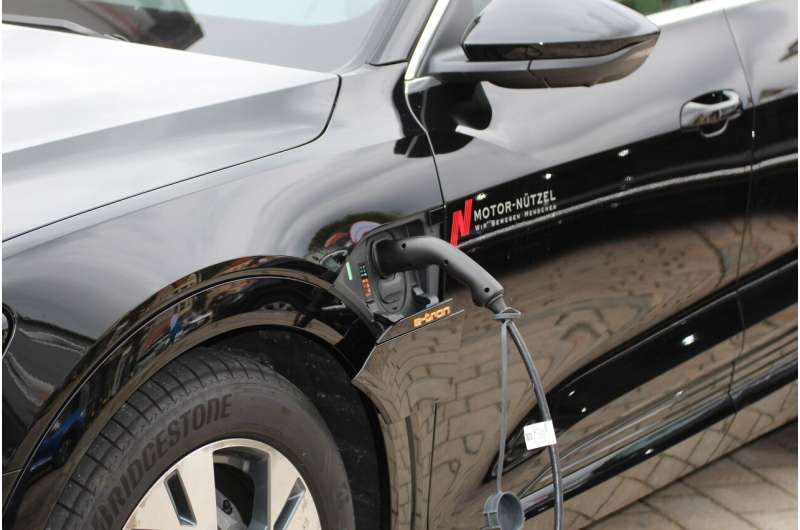This article has been reviewed according to Science X's editorial process and policies. Editors have highlighted the following attributes while ensuring the content's credibility:
fact-checked
peer-reviewed publication
trusted source
proofread
Free electric vehicle charging at work? It's possible with optimum solar

The global surge in electric vehicle sales has prompted an Australian university to explore how it could offer free or nominal EV charging facilities to staff and students by optimizing its solar PV system and minimizing workplace electricity costs.
Engineering researchers based at the University of South Australia (UniSA) Mawson Lakes campus say that using renewable energy to power EV day charging is the key, lowering electricity grid demand in the evening and helping to support Australia's net zero emission targets by 2050.
The campus currently has rooftop solar panels on 18 buildings, supplemented by ground-mounted solar panels. The 2019 installation was based on energy needs at the time, but prior to the rapid uptake of electric vehicles.
A new model proposed by the UniSA research team shows that by nearly doubling the existing PV system on campus, free charging could be available to more than 200 electric vehicles—or 25% of the available parking spots on campus.
By introducing a nominal charging fee, the campus could support 100% EV penetration in the future, saving more than 20% in energy costs.
UniSA Professor Mahfuz Aziz, Dr. Mohammed Haque and UniSA Ph.D. researcher Yan Wu have published their findings in the journal Renewable Energy.
"We looked at different models to determine the most efficient way to support electric vehicle charging, while decreasing the campus's net annual energy costs," says Yan Wu.
"At 25% EV penetration, the UniSA Mawson Lakes campus could reduce its annual electricity costs by more than 9% by upgrading its existing solar PV system to optimum capacity, supporting free EV charging during the day. This would also help lower peak power demand by at least 12%.
"By optimizing the PV system, more energy would be exported to the grid, which does not attract any revenue. However, providing EV charging services at a nominal fee using the excess PV generation is a sensible solution.
"By doing so, the campus can potentially support 800 EV cars, the maximum number of parking spaces at Mawson Lakes, while incurring almost the same annual energy costs as that for 25% penetration with free charging."
The researchers used data from the Victorian Integrated Survey of Travel and Activity (VISTA) to obtain average daily travel distances and campus arrival/departure times. The modeling based on this data was further validated using actual parking data from Monash University's Clayton campus.
South Australia has a very high rate of solar PV penetration, driving high solar generation during the day. This results in a substantial decrease in grid power demand around midday and a dramatic increase in grid demand during the evening when solar generation falls.
"This causes significant operational challenges," says Professor Aziz.
"Excess power generated by rooftop solar and exported to the grid creates major grid issues as dispatchable power must be ramped up suddenly to replace dwindling solar power later in the day, causing a so-called duck curve.
"Workplace charging of EVs helps address this challenge by using excess renewable generation during the day. Prioritizing daytime workplace charging reduces pressure on the grid during the evening peak hours by decreasing the demand for home charging of EVs.
Dr. Haque says Australia would use solar more efficiently if it established comparable EV charging infrastructure in private and public facilities.
"This initiative not only helps in achieving a more balanced grid demand profile, but also promotes a greener environment," Dr. Haque says.
In proposing the smart EV charging models, the researchers considered the annual cost of grid electricity consumption, the costs of PV generation and EV chargers, and the annual revenue from EV charging fees. They calculated that the number of EV chargers should be about 69% of the actual number electric vehicles on campus.
According to the Global EV Outlook 2023, worldwide sales of electric vehicles almost doubled in 2022 compared to 2021, with more than 26 million EVs sold. That represents a 60% increase on 2021 and more than 500% higher than in 2018.
Australia intends to increase EV penetration to around 25% by 2030 and more than 80% by 2050, based on the 2021 EV Opportunity Assessment Report and the Australian Electric Vehicle Market Study. The ACT has officially announced its intention to ban the sale of new fossil fuel-based cars by 2035.
More information: Yan Wu et al, Techno-economic modelling for energy cost minimisation of a university campus to support electric vehicle charging with photovoltaic capacity optimisation, Renewable Energy (2023). DOI: 10.1016/j.renene.2023.119427


















